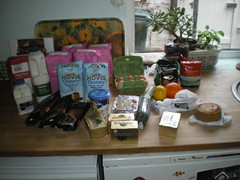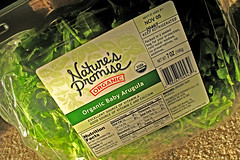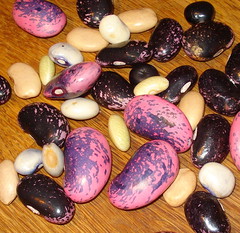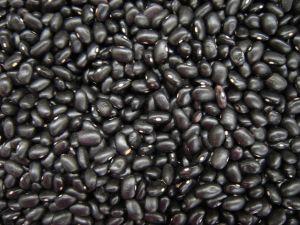40 Painless Ways To Trim The Grocery Budget
 photo credit: KarlOnSea
photo credit: KarlOnSea
For the past 3 years, our family of 6 has stuck to a very tight grocery budget. It has gone up $100 since we really started budgeting our food dollars. However, in those three years we have added another 2 mouths to feed and allowed for some wiggle room due to rising food prices. Our current monthly grocery budget is $350.
Here are some of the methods I’ve implemented into my shopping and cooking habits that enabled me to trim our budget and stay on track every month.
- Menu planning. I plan both monthly and weekly to allow for variations and daily taste preferences.
- Master grocery list. Having a list of all the things we usually buy, organized by aisle, really helps to keep me on track when I’m preparing for a trip to the grocery store.
- Price book. My version of a price book is not very traditional. Instead, I list the regular prices right on my master grocery list. Both methods are a great way to track your spending before you ever hit the store though. A price book also helps you decide which store to shop at based on where they have the best sales.
- Coupons. I clip coupons from the usual places (newspaper inserts, magazines, sales flyers, etc.) and I print coupons from the web or upload coupons directly to my store loyalty card. However, I also stick with the mantra that I only use coupons for foods we really, truly need and will want. Even then, I only buy with coupons if the price is less than a generic counterpart.
- Store loyalty card. I save hundreds of dollars every year by using store loyalty cards. Not only do they allow me to get both advertised and unadvertised sales, but they allow me to double certain coupons. Also, some grocery stores send out quarterly coupon booklets to their loyal shoppers.
- Shopping on a full stomach. This makes it much easier to avoid spur-of-the-moment splurges.
- Shopping alone. Again, this makes it much easier to avoid spur-of-the-moment splurges aimed at appeasing impatient children or husbands.
- If #7 is not possible, using alternative methods to keep little hands occupied. I like to print out picture lists for each of my children and they are responsible for getting each item on their list before we leave the store. Often, they are so busy watching for the next thing they need that they don’t even notice the usual enticements.
- Shopping from the list and nothing but the list. I don’t even consider an item unless it is on my list. Even my kids know this and practice it whenever they are at the store with me.
- Shopping less frequently. Currently, I do one large grocery trip just once a month and my husband makes any extra needed stops throughout the month for produce or dairy items. I have noticed that the more trips I make to the store, the more money I have spent by the end of the month.
- Using a calculator. I total the groceries on the list before we ever go to the store. I also keep track of the prices while shopping. This helps to avoid any mistakes at the register and keeps me on task.
- Paying attention to the labels. Sometimes the larger package is a better buy and sometimes it’s the smaller one. The only way to know for sure is to examine the price per unit labels on the store shelves.
- Watching for manager’s specials. Typically I find great deals in the produce, meat and dairy departments on items that are nearing their expiration dates. Then I either freeze the items as is or quickly use them in a dish that can be frozen. However, if I’m unsure if I’ll be able to use or process the item before it goes bad, I’ll pass on the great deal.
- Knowing the store policies. A few of our local grocery stores have a policy that if you find an expired item on their shelves, you can receive the same, unexpired item for free.
- Getting acquainted with store employees. The meat department manager at the store I usually shop at and I are on friendly terms. Because of this, I never hesitate to ask him the regular times when they mark down products or to save bones for me that I can use in stocks.
- Not being afraid to ask. If I see an item that is near its expiration date and is not marked down while other similarly dated products are, I’ll ask the department manager if I can receive the same markdown for the item I want. Usually, they are more than happy to oblige.
- Taking advantage of rain checks. Sometimes it can seem like a hassle to wait in line at the service counter in order to receive a rain check for the sales price on an out-of-stock item. It is time well spent though, especially if the sales price is really good.
- Knowing the sales cycles. I try to pay attention as closely as possible to the sales cycles at my grocery stores. Many sales center around a 6 week cycle. When I see that cycle begin, I try to stock up enough to last until the next cycle.
- Stockpiling. I don’t do this at every trip, but whenever I have a little extra wiggle room in my monthly budget, I stockpile items that are on sale. These extras really come in handy on months when there is absolutely no wiggle room or when the trip to the grocery store has to be delayed.
- Buying generic. For the most part, everything we buy at the grocery store is a generic, store-label product. The quality on these items has really improved over the past few years while the savings ratio has stayed the same. If you are unsure of generics, try at least one different variety on every trip before you write them off completely. Then, continue to choose the generic for everything that passes your taste test.
- Skipping soda. We do not buy soda at our house. It is not a necessity.
- Being smart with organic items. There are many organically labeled products that are just not worth the added expense.
- Cooking from scratch. Scratch-cooking saves our family hundreds of dollars every month over the cost of convenience, pre-packaged items.
- Eating vegetarian meals at least twice per week. There are so many meat-free options for getting a protein rich meal. Often, these options are just a fraction of the cost of meats.
- Stretching whenever possible. I am always looking for ways to stretch our foods. For example, I stretch sloppy joe meat with cabbage, Mexican dishes are stretched with rice, and meatloaf is stretched with lentils.
- Substituting creatively. I am always looking for ways to substitute expensive ingredients for more frugal options. For example, I’ve learned through trial and error that 1/4 cup of nuts can often be used instead of a whole cup in baked goods.
- Ignoring recipes calling for expensive items. Although I like to use a lot of variety in my kitchen, I avoid recipes that call for high priced ingredients.
- Freezer cooking. With 4 young children, I have yet to find the time for a rigorous Once-A-Month cooking session. However, I do double or triple recipes whenever possible and freeze the extras. This really helps keep our food budget down, especially on those busy days when I’d otherwise be tempted to use convenience foods or take out.
- Using up leftovers. I try to make sure all leftovers get eaten. They make a quick lunch on a busy day or a fun buffet-style dinner when there are lots of leftovers. If I know certain leftovers will not be eaten soon enough, I’ll freeze them for a later date.
- Eating healthy and complete breakfasts. When my family starts the day with a nice hearty breakfast, we are all less likely to snack later on.
- Keeping the scraps. I freeze vegetable scraps and peels to use in making vegetable and meat stocks.
- Not letting produce go bad. If I notice some produce is beginning the quick decline to rotten, I will either cook and freeze it or just dice and freeze. This can then be used in casseroles or soups. Frozen fruit is perfect for making homemade smoothies.
- Serving proper portion sizes. Its easy to overeat when a too large plate filled with food is placed in front of us. Besides not being healthy, overeating is not very frugal either.
- Preparing for out-of-season produce. I stock up on summer-only produce when I can and freeze, dry or can it for the winter months.
- Storing foods properly. With a little research, I’ve learned the proper and improper ways to store all sorts of food to prolong shelf life. This prevents things from going bad too soon.
- Making my own stocks. Homemade stocks allow me to get the most out of things that are normally thrown away (bones from meat, vegetable peels, etc.). They also provide a great base for cheap soups or sauces and gravies.
- Making homemade baby food. Homemade baby food is incredibly easy to make, healthier than canned versions, and much cheaper.
- Never being afraid to try. Although some meals will flop, I’m always willing to experiment on more frugal options. The flops aren’t frugal, but they are rare and a worthwhile risk.
- Allowing for treats. Treats make sticking to a frugal grocery budget much easier for the whole family than depriving ourselves things we really enjoy. In our house, that means there is always room in the budget for ice cream.
- Knowing when to stop. Sometimes, there are just no ways left to trim the budget. Instead of feeling defeated, enjoy the money you have been able to save and be happy with your current budget.
20 Organic Foods That Are Not Worth The Extra Cost
 photo credit: Mr. T in DC
photo credit: Mr. T in DC
I strive to feed my family as healthfully as possible while still sticking to a tight grocery budget. For my family, healthy eating includes eating organically whenever possible. Yet the organic foods we eat have to be tempered against our frugality.
The desire to eat organic on a frugal budget has lead to a lot of research on my end. Surprisingly, I have found there are many organic foods that just are not worth the extra expense. Whether because of minimal pesticide residues or preparation methods, these 20 foods do not warrant the additional organic cost.
- Bananas
- Pineapple
- Asparagus
- Onions
- Garlic
- Broccoli
- Cabbage
- Papaya
- Corn
- Peas
- Mango
- Kiwi
- Avocado
- Cauliflower
- Wild or farmed fish (due to the lack of restrictions necessary for an organic label)
- Frozen varieties of any of the above produce
- Condiments (ketchup, mustard, mayonnaise – unless your family eats these items in great quantity)
- Convenience foods
- Snack foods
- Frozen meals
The last three on the list can be made from scratch with organic products for much less, per serving size, than the cost of already prepared counterparts. Plus, a potato chip really isn’t that healthy in any form, organic or not, so we skip the chips, and other similar snacks, all together.
5 Simple Ways to Use Canned Black Beans when Frugality Rules
 photo credit: net_efekt
photo credit: net_efekt
If your family budget is stretched just about as far as it will go, and who’s isn’t, you need some proven tools to stretch your money even further. One of the methods most of us use to squeeze a few more pennies out of our paycheck is to cut back on the grocery bill. Let me introduce you to your new best friend; superbly nutritious and wonderfully delicious, the Black Bean.
If you find yourself wandering through the aisles of your grocery store, searching for something to make for dinner that won’t rob you of your last dollar, mosey on over to the black bean display and check out the price. Read the label and you’ll learn that black beans are loaded with nutrients like protein, iron, calcium, and potassium, and they are high in fiber, and low in fat and sugar, so they really offer a lot of bang-for-your-buck. With those kind of credentials, it is obvious that black beans should be a staple in every household, frugal or not. So, let’s think up a few simple and delicious meals to create using your new best friend… the black bean.

1) Simply Delicious Four Bean Soup
You’ll need 1 can each of black beans, garbanzo beans, butter beans, and navy beans, drained but not rinsed, and set aside. In a large pot, pour 2 tablespoons olive oil or vegetable oil, add 1 cup finely chopped celery and 1 cup diced onion. Cook over medium to medium low heat until celery is a little transparent and tender. Then, add 1 clove garlic, minced, crushed, or grated, and cook for just about a minute. Add 1 small can fire-roasted diced tomatoes and 1 small can chicken broth. Simmer slowly for about 20 minutes. Give it a taste and add salt and ground black pepper to taste. You may also want to sprinkle in some hot red pepper flakes if you like a bit of spice. That’s all it takes and it’s ready to eat, and healthy, too.

2) Beans and More Beans Salad
Like any salad, you want to use a variety of color and textures. Choose solid beans, like black beans, butter beans, garbanzo beans, kidney beans, waxed beans, and the like for a nice mix of colors. Drain and rinse all the beans and put them in a big bowl. Now, you want to add some nice crunchy texture and more color. Be sure to add some sweet onion, or green onion with the tops, some beautiful chopped sweet red pepper, finely chopped celery, maybe some chives, a little parsley, dill perhaps, or whatever herb you have that sounds good, and top it all with a drizzle of a good vinaigrette dressing like Paul Newman’s Own Balsamic Vinaigrette. Give the salad a good, but gentle, toss so all the ingredients are distributed. This is a surprisingly easy and flavorful recipe and makes a really refreshing salad. Even the kids will enjoy this salad, which is great because it’s loaded with nutrition.

3) Under a Minute Black Beans and Taco Sauce
My daughter actually created this recipe and, although it may appear a little strange at first, it certainly has its merits and has made me a true believer in sometimes simple is best. You’ll need to drain and rinse your canned black beans, being sure they drain thoroughly and you don’t end up with water in your bowl. After your canned beans are rinsed, pour them into a bowl and simply top with any favorite taco sauce, like those little leftover ones we seem to accumulate from getting take-out. Mix the taco sauce in gently but thoroughly, give it a taste test, add more taco sauce if you like, and enjoy! You just have to trust me on this one. It makes a great side dish or after school snack, and is loaded with nutrients that you don’t get in a lot of other snacks. You can also use taco sauce you have in your refrigerator, or even a bit of salsa. Just don’t overdo the sauce. You want the flavor of the salsa or taco sauce to enhance, not overwhelm the black beans.

4) Black Bean and Celery Cottage Cheese Salad
Creating salads that use black beans is a great way to add another nutritional element to any meal. This salad is almost a meal in itself. Start by putting a 1 cup scoop of cottage cheese in a serving bowl, and sprinkle a little salt and freshly ground black pepper on top. Drain and rinse a can of black beans, being sure they drain well. Top the cottage cheese with about 1/2 cup of the black beans. Add about a handful of chopped celery on top and you have a great, crunchy, creamy lunch that’s packed with protein, calcium, iron, and fiber. Did I say this was almost a meal in itself? It IS a meal in itself!

5) Whatcha Got Black Bean Burrito
If you have a few staples in your pantry you can whip up this simple and nutritious burrito. You’ll need a flour or corn tortilla, heated if you like, placed on a plate. Drain and rinse your black beans thoroughly, then start building your burrito however you want with whatever you have in the kitchen. I add my black beans first, then some diced tomatoes, leftover rice if I have it, a little onion, lots of shredded cheddar cheese, a little sour cream or cottage cheese, some chopped parsley or cilantro if it’s in the refrigerator, some leftover fish is nice, and whatever else I have to use up. Depending on how my stash of leftovers is, I go a little heavier on the black beans and lighter on the other stuff. Then, sit down with your bottle of taco sauce or salsa, and enjoy!
These are just a few of the countless ways to enjoy cooking and serving the incredibly nutritious and inexpensive black bean. You can see why I’ve befriended black beans and added them to my pantry staples. The five meal ideas I’ve given here can easily be built upon to add your own personal flair and create black bean dishes that you can call your very own family favorites.
Please stop by often and share your own frugal ideas for living.
Feeding a Family for $300 a month?
By Tawra Kellam
I do something that most people think they can’t do today. I feed my family of 5 for $300 a month. Most people say that’s an impossible feat, but what boggles minds even more is that I do it without using coupons.
How do I do it? First, I use what I have. If I don’t have milk in the house, I don’t make a special trip to the store for it. The kids won’t die from malnutrition if they miss drinking milk for a day or two. If I’m out of bread, I’ll make some cornbread or muffins. If I’m out of fresh veggies, I will use canned or frozen instead. Stop going to the store for one or two things. I shop for food 2-3 times a month and that’s it. You’d be amazed how much this saves on the cost of gas.
Shopping the clearance sections, I regularly find milk on clearance for $1.20 a gallon. My store marks the milk down a few days before the “sell by” date. The great part is that milk stays fresh for 1 week after it’s opened. I generally only buy the milk when it’s marked down and I buy enough to last until the next time I find a great deal on it. I throw several in the freezer and then I don’t have to make a special trip for milk (or pay the premium price). Just thaw, shake and serve.
Purchase meat only on sale or on clearance. Again, butchers mark down their meat a day or two before the “sell by” date. Generally, meat is good for 3-4 days after the “sell by” date in the fridge or 6 months in the freezer.
I never buy meat unless it’s on sale for $1.99 or less a pound. If it’s not on sale, we don’t eat it. (Even so, we never have a shortage of meat in our house.) You can get some great unadvertised deals just by watching the meat counter’s clearance items. I found 5 lb. rolls of hamburger for $2.95 each just the other day. Of course, I stocked up and will have enough hamburger to last the next 6 months.
I can get “soup bones” with enough meat on them to make a great vegetable stew for under $2.00 for the entire family! Add some rolls and you have a complete meal for 5 for less than $3.00. When chicken is on sale for $1.66 per pound, I stock up. I do this with all my meats. This way we can always have a variety of meats.”
Another important tip: Ask. Most people are intimidated by asking, but I regularly ask when things will go on sale or be marked down. By asking, I’ve found out that bananas, milk and meat are marked down each morning. I try to shop in the mornings to get the best deals. When we lived in Texas, the stores marked things down in the evening, so we made it a point to go shopping in the evening. Adjust your shopping times to find the best deals.
Serve your family proper portions of food. Most parents give their kids way too much milk, juice and soda. My kids get soda on special occasions only. They eat milk with their cereal. For snacks, they eat a piece of string cheese, fruit or one or two cookies. The kids don’t sip on milk or juice all day long. They drink water and are just fine with it.
As a general rule, I try to give them one vegetable and one fruit for lunch and dinner and then a piece of fruit with cookies or cheese as a snack.* This way, they get their “five a day” in very easily. Stop letting kids just “graze” on chips and other snack food all day. My kids get one small “bowl” of chips (1/2 cup to 1 cup depending on the size of the chips) a day and that’s it.
So what do we eat? Here are some of our menus:
*Slow cooked roast,* brown gravy, onions, carrots, potatoes, buttermilk muffins and a fruit plate (The next day, the leftovers from the roast are used as barbecue beef along with potato salad, green beans and strawberries or grapes.)
*Pizza (homemade),* tossed salad and fruit
*Maple glazed chicken,* scalloped potatoes, glazed carrots,applesauce and dinner rolls
*Sloppy Joes,* cucumbers and tomatoes
*Tacos,* refried beans, green beans, sliced apples and tortilla chips w/ honey
With savvy shopping, you to can cut your grocery bill even when prices are going up!
Frugal Meals
Frugal Grocery Shopping– How can you save money on your grocery bills?
Quick Kids’ Meals– What do you do when you need to put dinner on the table in minutes?
Healthy Kids Meals – It’s not as difficult as you might think to make healthy meals your kids will love.
Cheap Party Food – Cold Pasta Salad – When you need to bring a dish, pasta salad is quick and painless.
More Cheap Party Food– How to throw a Frugal party the Easy Way.
Banish Boring Brown Bag Lunches! – These simple ideas are cheaper and healthier than dining out.
Frugal Nutritious Snacks for Children– Save money on food and medical bills by providing healthy snacks.
Freezer Cooking: A gift for Frugal Moms– How can I save time in the kitchen, make healthier meals and save money — at the same time?
Stocking Your Pantry: Meals in Minutes – Take-out food is so expensive. When you do a little preparing, you can actually fix meals in minutes.
Save Money, Grow Your Own Herbs – The high price of herbs at the grocery store may make you wonder — Why not save some money and grow your own? It’s simple, provided you have a sunny area to grow them.
Thrifty Meal Idea for Frugal Moms – Submitted by Thrifty Moms like You
Cheap Romantic Meals – Frugal Meals for a Romantic Evening.
Recommended Frugal Eating Resources
Frozen Assets: How to Cook for a Day and Eat for a Month
Frozen Assets Lite and Easy: How to Cook for a Day and Eat for a Month
Cook for a Day: Eat for a Month : Frozen Assets Readers’ Favorite
Thrifty Frugal Meals
Simple Living, Frugal Eating
submitted by Moms like You
Thai Ramen Soup
Instead of making plain, ol’ cheap Ramen Noodle Soup… I take the Spicy Chicken Soup… and, just when the noodles are almost cooked all the way, and there is only a little bit of water left, I drop in a tsp of peanut butter (chunky is good!) and a dash of cayenne pepper. Makes the soup more like a Thai dish… more filling… substantial… tasty… and CHEAP! – Jill Hood
Crock Pot
Your Crock-Pot is your best friend. It really can make fabulous meals that require few ingredients which means it’s less you’ll spend on groceries. You’ll also save yourself time too, since you can make all in one dishes in a very short amount of time! – Shelly Howard, owner Munchkin Menus
Organic Farms
Find an organic farm nearby and ask if they provide a weekly “harvest basket”. One of our local farms provides a weekly harvest basket for $10 which includes enough fresh fruits and vegetables to feed our family for a week! The produce is fresh and because it’s organic, it lasts and lasts much longer than store-bought produce. I also find it so much easier to include fresh veggies in our meals when I don’t have to shop for them separately! — Ellen, slocountymoms.com
How to Make Meatloaf? – Quick Easy & Frugal Meatloaf Mix
